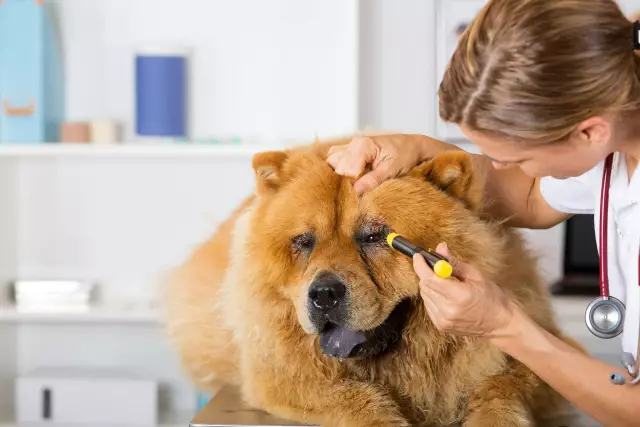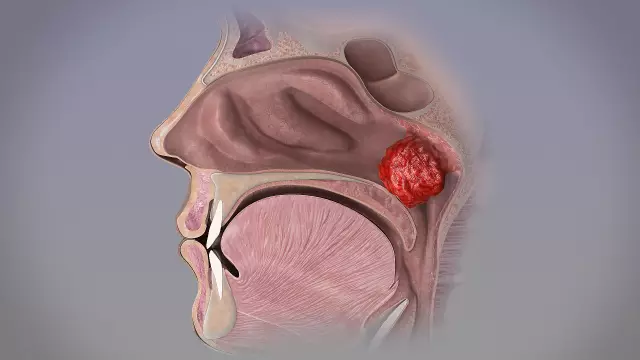- Author Rachel Wainwright [email protected].
- Public 2023-12-15 07:39.
- Last modified 2025-11-02 20:14.
Cough and cold inhaler: how to choose the right device and use it correctly
The content of the article:
-
The main types of inhalers
- Ultrasonic inhalers
- Compressor inhalers
- Electronic mesh inhalers
- Steam inhalers for cough and runny nose
- How to choose the right inhaler for the treatment of respiratory diseases
- The best manufacturers of inhalers
- How to use an inhaler for coughs and runny nose
- General rules for inhalation at home
- Contraindications for inhalation
- Video
A cough inhaler is a special medical device that allows a drug to enter the respiratory tract and provide a therapeutic effect directly at the site of inflammation.
The main symptoms of a cold are dry cough and runny nose. A very effective way to eliminate them is inhalation, that is, medical procedures in which the drug enters the respiratory tract in the form of smoke, steam or aerosol. It is convenient to use an inhaler for their conduct at home. The range of these devices is currently extensive and often the consumer has difficulty choosing a specific model. In this article, we will talk about the main types of inhalers, their advantages and disadvantages, and also tell you how to use the inhaler for coughing in adults and children.

Inhalers for small children can be produced as fun toys
The main types of inhalers
Depending on the principle of operation, the whole variety of inhalers is divided into several types:
- compressor rooms;
- electronic mesh;
- ultrasonic;
- steam.
The first three types of inhalers are combined into one group and are called nebulizers. The principle of their work consists in the formation of a suspension of the smallest particles of the drug - aerosol. During inhalation, these particles enter the airways and are deposited on the mucous membrane. The particle diameter of the aerosol depends on the type of device. It is important to take this indicator into account when choosing a specific model, since the finer the particles of the drug, the deeper they penetrate into the respiratory tract.
The principle of operation of steam inhalers is based on heating the drug with the formation of steam, which the patient inhales.
Let's take a closer look at each type of inhaler.
Ultrasonic inhalers
Devices of this type form aerosols with the smallest diameter of active particles, which are able to penetrate well into the most inaccessible parts of the ENT organs and respiratory tract.
The principle of operation of the device is based on the vibration of a special emitter plate in the ultrasonic range. Under the influence of vibration, the liquid breaks up into tiny droplets, the size of which reaches 5 microns.
Ultrasonic inhalers are highly efficient: in 10-15 minutes of operation, the device is able to process up to 30 ml of drug solution into an aerosol.
With the help of ultrasonic nebulizers, inhalation can be carried out using:
- expectorant drugs (Ambrobene, Lazolvan);
- anti-inflammatory and antimicrobial drugs (Dekasan and others);
- alkaline solutions (baking soda solution, alkaline mineral degassed waters such as Borjomi).
The main advantages of ultrasonic nebulizers are:
- small size, which allows you to take the device with you on the road and carry out inhalations not only at home, but also in any other place (at work, on a train, on an airplane);
- the presence of additional masks and attachments in the kit, which make it possible to use the device in children and adults, as well as in bedridden patients.
Compressor inhalers
In terms of their performance, compressor inhalers are similar to ultrasonic ones, but differ from them in greater weight, size, and increased noise during operation.
During operation, the compressor creates a powerful air stream that is fed into the medicine chamber through a very small opening. This leads to the formation of an aerosol cloud.
The main advantage of a compressor nebulizer is that this device can spray almost any solution of drugs used for inhalation.
Electronic mesh inhalers
This type of inhaler has recently appeared on the domestic market. The principle of their operation is based on the low-frequency sputtering method. Electronic mesh inhalers allow inhalations with various drugs:
- antibiotics;
- hormones;
- mucolytics.
In addition, oil inhalations can be carried out using the device (the oil must be of a certain viscosity level).
When choosing a cough inhaler for children, it is recommended to give preference to electronic mesh models, since they are distinguished not only by high efficiency, but also by almost silent operation, so their use does not cause fear and any negative emotions in babies.

Electronic mesh inhalers are the most convenient to use
Steam inhalers for cough and runny nose
A steam inhaler, as is clear from the very name of the device, converts a liquid medicinal substance into steam under the influence of heating. At its core, this is an improved "grandmother's" cough treatment - breathing over a pot of hot boiled potatoes. The only advantage of the device is its low price. It has much more disadvantages:
- the concentration of the active medicinal substance in the vapor is minimal, which makes inhalation ineffective;
- under the influence of high temperature, the destruction of the active component of the drug may occur;
- the high temperature of the inhaled vapor gives the patient a lot of discomfort and can cause a burn of the respiratory tract.
Steam models should not be used in children's practice. Babies refuse to do inhalation, as the steam burns the mucous membranes of the nose and mouth. In addition, after entering the respiratory tract, the vapor condenses into small droplets. If the technique for performing the procedure is violated (the amount of solution used, the duration of inhalation is changed), then an excess volume of fluid may accumulate in the child's bronchi, which, in turn, will provoke an increase in coughing and may even cause the development of pneumonia.

Steam inhalers are not intended for use in pediatric practice
How to choose the right inhaler for the treatment of respiratory diseases
Before buying an inhaler, many users use the Internet, as evidenced by the high frequency of the request: "inhaler rating". But choosing a medical device is wrong. As mentioned above, each type of device has its own characteristics, advantages and disadvantages.
For example, steam and ultrasonic models of inhalers are not suitable for patients suffering from allergic bronchitis, bronchial asthma or cystic fibrosis, since they are not intended for inhalation with steroid hormone solutions. In this case, an electronic mesh inhaler is a good choice.
If a child often has to be treated for respiratory diseases, then compression models of inhalers are preferred. They can be used with a wide range of drugs, provide a quick effect and at the same time belong to the middle price segment.
For people with chronic respiratory diseases (bronchial asthma, allergic cough, obstructive bronchitis), an important parameter of the inhaler is its mobility, as well as the ability to use the device from batteries or rechargeable batteries.
When buying an inhaler, you should pay attention to its complete set (children's and adult masks, nasal cannulas, replaceable filters), clarify the features of the device operation and methods of its disinfection.
Thus, when choosing an inhaler, it is better to rely not on the reviews of other users, but to seek advice from your doctor and follow his recommendations.
The best manufacturers of inhalers
Currently, in pharmacies and medical equipment stores, inhalers produced by many foreign and domestic companies are presented. However, according to sales statistics, devices of the following brands are in greatest demand:
- Well. An English company specializing in the production of inhalers designed for people of all ages. For children, nebulizers are made in the form of trains, which eliminates the fear of babies before the procedure. The main advantages of the products of this company are reliability, high quality and reasonable prices.
- A company from Japan that produces inhalers not only for home but also professional (clinics, hospitals, sanatoriums) use. There are official representations of the company in almost all countries of the world, so users usually do not have problems with the maintenance and repair of inhalers.
- A&D. The products of this Japanese company are of high quality and affordable prices. The assortment includes inhalers designed for both medical institutions and for home use.
- Little Doctor International. A Singapore-based company that manufactures various types of nebulizers. Its products successfully combine qualities such as affordability, safety, reliability and functionality.
Russian-made inhalers are also popular among buyers, as they differ in good functionality and low price.
How to use an inhaler for coughs and runny nose
Before starting the procedure, you must thoroughly wash your hands with soap and running water. After that, assemble the device in accordance with the instructions attached to it. The required volume of physiological sodium chloride solution is poured into the inhaler container, and then the amount of the drug prescribed in the doctor's prescription is added to it. To fill the container, sterile disposable syringes are used to measure the exact volume of the drug and to avoid microbial infection.
Inhalation is usually carried out until the drug solution is completely consumed. This usually takes 8-10 minutes (unless otherwise indicated by your doctor). It is unreasonable to increase the duration of the procedure beyond this time.

Convenient when the nebulizer is equipped with masks of two sizes - for children and for adults
Immediately after the end of inhalation, the nebulizer is disassembled and its parts are washed in a hot soapy solution without using brushes and brushes, and then thoroughly rinsed under running water. Every 7-10 days, the device should be deeply disinfected using the method specified in the instruction manual. After processing, the parts of the nebulizer are stored wrapped in a clean, dry linen napkin.
General rules for inhalation at home
In order for inhalations to have a quick therapeutic effect, it is necessary to observe a number of rules during their implementation:
- the procedure should be performed no earlier than 1.5-2 hours after physical exertion or eating;
- breathe correctly (for diseases of the ENT organs, inhale through the nose, and for diseases of the bronchi - through the mouth);
- do not talk;
- mucolytic drugs should not be taken immediately before inhalation;
- after inhalation, rinse your mouth with warm boiled water and wash yourself with running water;
- after inhalation, you should not talk, drink, eat, go outside for 15-20 minutes;
- inhalations are performed no more than 2-3 times a day, unless otherwise prescribed by the attending physician.
Contraindications for inhalation
Like any method of treatment, inhalation has not only its indications, but also contraindications. Despite all the advantages of the method, inhalation is no exception to this rule. They cannot be carried out in the following cases:
- increased tendency to nosebleeds;
- hemoptysis, pulmonary bleeding;
- bullous emphysema of the lungs;
- pneumothorax (spontaneous, traumatic);
- severe heart failure;
- heart rhythm disturbances (arrhythmia);
- individual intolerance to the drug (allergic reaction).
Video
We offer for viewing a video on the topic of the article.

Elena Minkina Doctor anesthesiologist-resuscitator About the author
Education: graduated from the Tashkent State Medical Institute, specializing in general medicine in 1991. Repeatedly passed refresher courses.
Work experience: anesthesiologist-resuscitator of the city maternity complex, resuscitator of the hemodialysis department.
Found a mistake in the text? Select it and press Ctrl + Enter.






